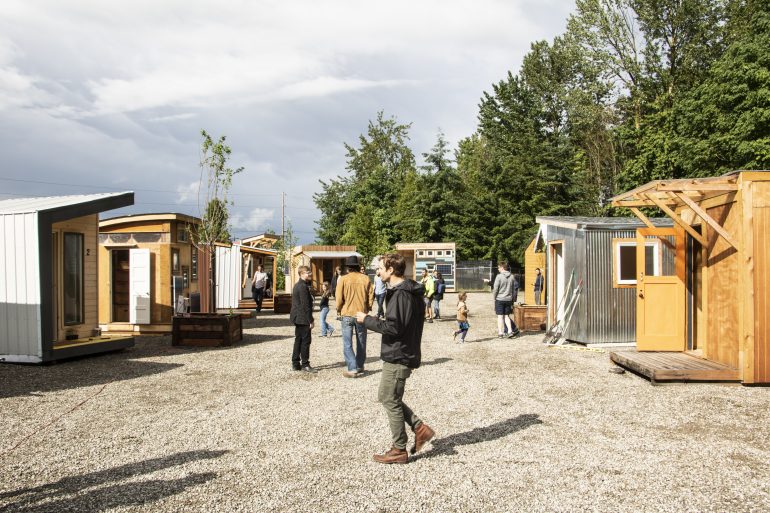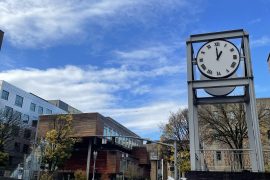Students from Portland State’s School of Architecture and Center for Public Interest Design, in conjunction with Portland’s Village Coalition, hosted an exhibit reception in Portland’s City Hall atrium to showcase village model design work meant to address houselessness. The exhibit was free and open to the public December 3rd–7th, 2018. It featured research, design, and action related to the villages and their ever-present changing role in our city.
The Village Model Design exhibit showcased work conducted by students in Professor Todd Ferry’s class that term. For three years, Ferry has taught a fall term architecture class that focuses on research, design and construction of pod homes for village models. Some villages that already exist in the area, such as the Kenton Women’s Village, Clackamas’ Veterans Village, and Agape Village, were featured examples that showcased this potential approach to address the region’s houselessness crisis.
Several displays pitched fictional scenarios developed by the design class, along with information about villages that are open and inhabited. For example: “What if a village improved the quality of its neighborhood?” This could be as simple as holding community events, litter clean-ups, providing community gardening spaces, or acting as a food hub.
The exhibit updated the public about plans for several existing villages.
The Kenton Women’s Village, which houses up to 14 female-identified people, will be moved this February to land that has a water main running through, making the location better suited for a pod village than a large development. A long-planned, low-income, affordable housing development run by Transition Projects will take its place.
Hazelnut Grove is one of the largest villages in the area. It was founded in September 2015 by a group of advocates and started out as a small group of campers. Most of the original campers from Hazelnut Grove have moved into permanent housing some of them while working and pursuing an education. The City of Portland has plans to move Hazelnut Grove to St. John’s in April 2019.
Church properties are potential sites for pod villages.
One question the students posed was: “What if every Portland religious institution contributed to a village?” In the City of Portland, there are 283 religious institutions. Portland Zoning Code allows religious institutions to host six transitional housing units on their property for up to 180 days. However, a conditional use permit could grant a religious institution the capacity to offer more units for longer periods of time.
Another scenario read: “What if the Grotto hosted a Village?” The Grotto, also known as The National Sanctuary of Our Sorrowful Mother, is 62-acres of land owned by the Catholic Church. Given its size and relatively flat surface, the Grotto could house around 20 sleeping pods. A village there would not only give inhabitants shelter, but access to basic human needs such as toilets, showers, and electricity.
Ferry’s class helped to create a front gate for Agape Village, which is in construction on property owned by Portland Central Nazarene Church, located at the base of Kelly Butte Point on the corner of SE 97th and Powell Boulevard. The area used to be a quarry, and the church would throw the occasional summertime youth cookout there. Now, the church’s ultimate goal for the space is to “create a village which involves the entire community in giving our neighbors a hand-up.” Agape Village will have a total of 15 sleeping pods. These pods are being built by a non-profit known as Cascadia Clusters. Additionally, Cascadia Clusters will have several groups of volunteers assisting them. Some of these groups will include inhabitants of the village, who will be paid and get some construction training. Since it’s private property, the city can’t do much to oppose the construction.
Other features
“Maker Village” was a particularly innovative aspect of the exhibit. Maker Village, managed by the Cascadia Clusters nonprofit, will house builders and provide an onsite tool shop during Agape Village construction. Once Agape Village is completed, Maker Village will be moved to another village construction site in the city.
The power of design
Ferry’s favorite part about teaching students to make the pod homes is the applicability of design. “When students can understand that design is this incredible tool that doesn’t just have to be dedicated to museums and jewels that primarily wealthy people get to experience,” Ferry said, “but really, [design] is something that can be transformative for underserved communities.” Ferry believes his students work can help solve the regional housing crisis: “The more opportunities we have to look at a problem from many different ways, the better.”




